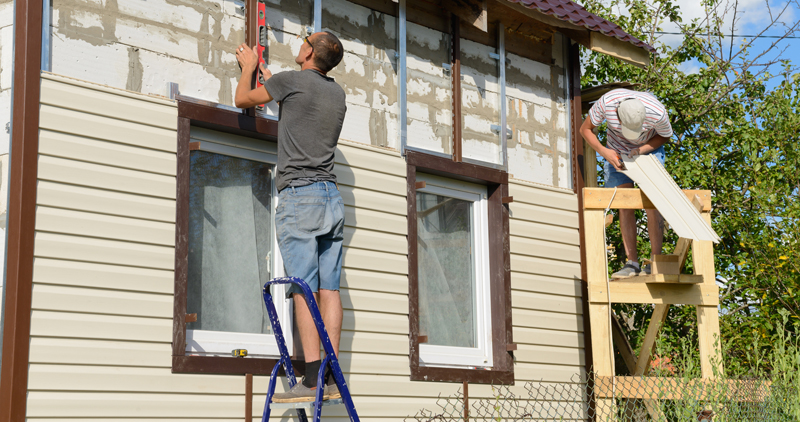How Much Does Vinyl Siding Cost? A Detailed Pricing Guide for Homeowners
Last Updated: October 04, 2023

Fact Checked By: Ryan Maguire
On This Page
To vinyl siding or not: that is the question you've probably asked yourself if your home siding needs replacing.
While purists insist on real wood, they might have a change of heart when their house needs to be scraped and painted every 10 years or so.
Vinyl, on the other hand, is very low maintenance, and advances in technology have vastly improved the material's overall performance and appearance.
How Much Does Vinyl Siding Cost? #
Vinyl siding is an exterior home siding made from PVC plastic. Here's a breakdown of typical vinyl siding costs:
Vinyl Siding Materials
- Basic vinyl siding - $2-4 per sq ft
- Premium vinyl siding - $4-7 per sq ft
- Insulated vinyl siding - $6-9 per sq ft
- Vertical siding - $6-12 per sq ft
- Shake & scallop siding - $7-13 per sq ft
Installation Labor
- Remove old siding - $1-3 per sq ft
- Install new vinyl siding - $3-5 per sq ft
- Paint & seal trim - $1-2 per sq ft
Other Project Costs
- Dump fees - $500-1,500
- Permit fees - $100-500
- Materials like underlayment and flashing - $1-2 per sq ft
Total Vinyl Siding Cost
- Small house (1,500 sq ft) - $8,000 to $16,000
- Large house (3,000+ sq ft) - $15,000 to $30,000+
In summary, expect to pay $6 to $12 per sq ft or $10,000 to $20,000 on average to reside a house with vinyl siding, including materials, labor and other project costs. Premium products, complex installations or large homes cost more.

Vinyl Siding Prices from Leading Brands Compared #
| Vinyl Siding Brand | Cost per sq ft | Warranty | Thickeness |
|---|---|---|---|
| CertainTeed | $5-$8 | Lifetime | 0.044" |
| James Hardie | $7-$10 | 30 years | 0.046" |
| LP SmartSide | $7-$12 | 50 years | 0.044" |
| Mastic | $3-$6 | Lifetime | 0.040" |
| Ply Gem | $4-$7 | Lifetime | 0.042" |
As you can see, top vinyl siding brands range from about $3 to $12 per square foot. CertainTeed, James Hardie, and Ply Gem are among the most popular and offer lifetime warranties.
Thickness is fairly standard at 0.040-0.046". LP SmartSide is premium strength siding costing $7-12/sq ft. Mastic is an affordable option starting around $3/sq ft.
Vinyl Siding Cost Calculator #
Total estimated cost:
Vinyl Siding Cost Examples #
Here are some real-life examples of vinyl siding installation costs:
A homeowner in Ohio paid $18,500 to reside their 2,000 sq ft colonial home with premium vinyl siding. This included tear-off, new insulation, materials, and professional installation.
A family in Minnesota spent $12,300 to install basic vinyl siding on their 1,600 sq ft ranch style house. They saved money by doing the tear off themselves.
A retired couple in Florida paid $22,000 to reside their large 2-story house with 2,800 sq ft. The job used thicker .050 vinyl siding and new vinyl soffits/fascia.
A DIY homeowner in California did their 1,200 sq ft bungalow for $7,500 in materials only. It took them 4 weeks of nights/weekends to self-install the new siding.
A historic homeowner in Maine paid $24,000 to reside 2,400 sq ft using insulated vinyl siding custom profiled to match the original wood siding.
As you can see, vinyl siding costs range from $3,500 to $30,000+ depending on the home's size, siding type, and DIY vs. professional installation. Most vinyl siding jobs cost $10,000 to $20,000 on average for materials and installation.
What to Know About DIY Vinyl Siding Costs #
Lower Material Costs - Buying siding materials yourself saves 20-30% over contractor rates. Shop sales at home centers.
Rental Equipment - You'll need scaffolding ($50-100 per day), lifts ($100-200 per day), and tools like nail guns ($30-50 per day). These rental costs add up.
Learning Curve - Installing vinyl siding well takes some practice. Allow for extra time and materials as you learn.
Labor Tradeoff - DIY installation takes much longer. Calculate if your time is worth the labor savings.
Removal and Disposal - Taking off old siding and disposing of it is difficult for DIYers to handle.
No Installation Warranty - Hiring a pro provides a warranty on the installation quality. Any issues are their responsibility to fix.
Permits - Permits are required in most areas. Know your local codes.
Overall, you can save around 20% in materials buying vinyl siding yourself vs. a contractor. But equipment rentals, extra materials, and time costs add up. For many homeowners, paying more for a pro to install faster and with a warranty is worth the added cost.
Vinyl Siding Basics #
When shopping for vinyl siding (PVC siding) and vinyl siding contractors, keep the following considerations in mind:
- Types: The types of vinyl siding can be broken down into its profile and texture. Among the former, choose from horizontal, vertical, shingle/shake, and faux layouts to make your home look accordingly modern, Victorian, European, etc. Popular vinyl siding textures include smooth, matte, and textured (made, for example, to resemble wood grain).
- Quality: Vinyl siding quality, generally measured by its thickness, can mean the difference between siding that sags, gets dislodged by wind, or takes impact damage within a few years of installation and siding that remains like new for decades. Minimum vinyl siding thickness is .035 inches, while premium siding is around .045 to .055 inches.
- Installation: Equally important to the quality of the vinyl siding itself is the quality of the installer. Because vinyl siding has a tendency to shrink in cold weather and expand in hot weather, an experienced contractor is a must. When choosing a contractor, ask for their certifications and to see examples of their past work. Signs of poor craftsmanship include bulging, warping, separation, sags, and ripples.
Reasons to Install Vinyl Siding #
Some of the reasons why more than 30 percent of homeowners choose to install vinyl siding on their homes, and why you should consider it for yours, are described below.
- Durability: Vinyl siding isn't maintenance free, its color can fade a bit over the years and panels can be damaged, as some proponents claim, but its ability to resist insect damage, dry rot, and moisture makes it very low maintenance compared to wood. In general, all that's required to keep vinyl looking like new is a cleaning solution, a soft brush, and a hose.
- Choice: The number of available vinyl siding styles, thicknesses, textures, profiles, layouts, and colors means there are virtually limitless options to choose from.
- Value: In many cases, the cost for vinyl siding installation is less than that of new wood siding. When you additionally consider that vinyl requires less maintenance, its value is even more apparent.
Pros and Cons of Vinyl Siding #
| Pros | Cons |
|---|---|
| Lower cost than wood or fiber cement | Not as durable or impact resistant as other sidings |
| Wide variety of colors and styles | Can dent, warp or crack over time |
| Low maintenance, no painting needed | Can look "fake" compared to natural wood |
| Insulated options improve energy efficiency | Fades over time, especially lighter colors |
| Lightweight and easy to install | Not fireproof or waterproof when damaged |
As you can see, vinyl siding offers advantages like affordability, low maintenance, and style options. But it does not match the authentic look or durability of wood or masonry. Overall, vinyl is a cost-effective cladding that works well when properly installed and maintained. The right choice depends on your budget and needs.
Vinyl Siding FAQs #
Here are some of the most frequently asked questions about vinyl siding installation:
How much does vinyl siding cost installed?
On average, expect to pay $6-$12 per sq ft for both vinyl siding materials and professional installation. The total cost for an average single-story home is $10,000-$20,000.
What is the cheapest vinyl siding?
Basic vinyl siding starts around $2-$4 per sq ft. While inexpensive, it may not last as long as premium brands. Mastic, CertainTeed Essentials, and Ply Gem Value Collection are budget-friendly options.
How long does vinyl siding last?
With proper installation and maintenance, quality vinyl siding will last 30-50 years. Look for siding with a lifetime warranty.
What thickness vinyl siding is best?
.044 inch thick vinyl siding is the industry standard. Thicker siding around .050 inch provides extra durability.
Should I go with insulated vinyl siding?
If energy efficiency is a priority, insulated vinyl siding with an insulation backing costs more upfront but can reduce energy bills.
What color vinyl siding fades the least?
Lighter vinyl siding colors tend to show fading sooner. Stick with darker neutral siding colors like browns, grays, or blues that resist fading longer.
How long does it take to install vinyl siding?
It typically takes 2-4 days to install vinyl siding on an average single-family home. Larger homes can take 1-2 weeks.
Sources:
